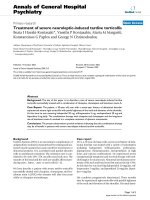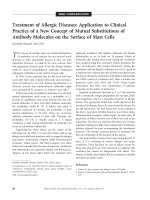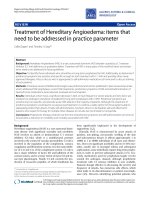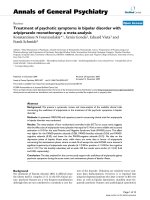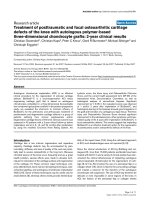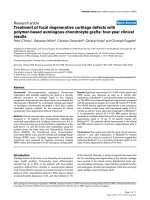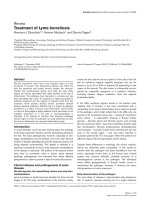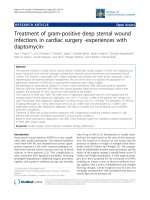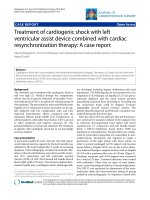Báo cáo y học: "Treatment of gram-positive deep sternal wound infections in cardiac surgery -experiences with" ppt
Bạn đang xem bản rút gọn của tài liệu. Xem và tải ngay bản đầy đủ của tài liệu tại đây (443.53 KB, 7 trang )
RESEARC H ARTIC L E Open Access
Treatment of gram-positive deep sternal wound
infections in cardiac surgery -experiences with
daptomycin-
Aron F Popov
1,2*
, Jan D Schmitto
1,3
, Ahmad F Jebran
1
, Christian Bireta
1
, Martin Friedrich
1
, Direndra Rajaruthnam
2
,
Kasim O Coskun
1
, Anselm Braeuer
4
, Jose Hinz
4
, Theodor Tirilomis
1
and Friedrich A Schoendube
1
Abstract
The reported incidence of deep sternal wound infection (DSWI) after cardiac surgery is 0.4-5% with Staphylococcus
aureus being the most common pathogen isolated from infected wound sternotomies and bacteraemic blood
cultures. This infection is associated with a higher morbidity and mortality than other known aetiologies. Little is
reported about the optimal antibiotic management. The aim of the study is to quantify the application of
daptomycin treatment of DSWI due to gram-positive organisms post cardiac surgery.
We performed an observational analysis in 23 cases of post sternotomy DSWI with gram-positive organisms
February 2009 and September 2010. When the wound appeared viable and the microbiological cultures were
negative, the technique of chest closure was individualised to the patient.
The incidence of DSWI was 1.46%. The mean dose of daptomycin application was 4.4 ± 0.9 mg/kg/d and the
average duration of the daptomycin application was 14.47 ± 7.33 days. In 89% of the patients VAC therapy was
used. The duration from daptomycin application to sternal closure was 18 ± 13.9 days. The parameters of infection
including, fibrinogen (p = 0.03), white blood cell count (p = 0.001) and C-reactive protein (p = 0.0001) were
significantly reduced after daptomycin application. We had no mortality and wound healing was successfully
achieved in all patients.
Treatment of DSWI due to gram-positive organisms with a daptomycin-containing antibiotic regimen is safe,
effective and promotes immediate improvement of local wound conditions.
Based on these obs ervations, daptomycin may offer a new treatment option for expediting surgical man agement
of DSWI after cardiac surgery.
Keywords: Cardiac surgery, Sternal infection, Antibiotic therapy, Daptomycin
Introduction
Deep sternal wound infection (DSWI) is a rare compli-
cation after median sternotomy. The reported incidence
varies from 0.4%-5%, and Staphylococcus aureus (gram-
positve organism) is the most common pathogen iso-
lated from infected sternal wounds and even in blood
cultures in these patients [1,2]. This complication is
often associated with significant morb idity, including
prolonge d hospitalization, additional surgical procedures
together with expensive antibiotic therapy and mortality
rates of up to 45% [2-4]. Mediastinitis is usually classi-
fied into five types based on the time of first presenta-
tion, the existence or absence of risk factors and the
presence or absence of single or multiple failed thera-
peutic trials (El Oakley and Wright) [5]. The manage-
ment of mediastinitis involves many procedures and the
choi ce of the surgical strategy is usually based on the El
Oakley and Wright classification. A wide range of strate-
gies have been proposed for the treatment of DSWI,
including an intense course of directed antibiotic ther-
apy together with a series of debridements and multip le
dressing changes. Closed irrigation may be used, but
eventually reconstruction with vascularised soft tissue or
muscle flaps can be necessary [6].
* Correspondence:
1
Department of Thoracic Cardiovascular Surgery, University of Göttingen,
Germany
Full list of author information is available at the end of the article
Popov et al. Journal of Cardiothoracic Surgery 2011, 6:112
/>© 2011 Popov et al; licensee BioMed Central Ltd. This is an Open Access article distributed under the terms of the Creative Commons
Attribution License ( which permits unrestricted us e, distribution, and reproduction in
any medium, provided the original work is properly cited.
Nonetheless, despite the use of perioperative anti-
biotic prophylaxis, mo dern surgical techniques and
careful wound treatment, DSWI will likely to remain a
complication of median sternotomy. As we see an
increase in the comorbidities identified as risk factors
for DSWI namely diabetes and obesity, refining the
therapeutic options to mediastinitis becomes even
more important [7].
Appropriate medical treatment of Staphylococ cus aur-
eus induced of DSWI very often involves the systemic
administration of vancomycin. However, th e use of this
agent has been associated with suboptimal outcomes
and can increase the risk of renal failure and the risk
developing a drug resistant organism. Because of these
deleterious outcomes, there is a definite need to find
alternate strategies for patients with mediastinitis post
cardiac surgery [8,9].
Daptomycin is a lipopeptide antibiotic approved by the
U.S. Food and Drug Administration (FDA) at a dose of
4 mg/kg for the treatment of complicated skin and skin
structure infections (cSSSIs) caused by susceptible iso-
lates of certain g ram-positive organisms. Daptomycin is
bacterici dal, and its mechanism of action is by depolari-
zation of the cell membrane [10].
The difference between daptomycin and standard
therapy in the treatment of Stap hylococcus aureus
methicillin susceptible (MSSA) infections was up until
now not statistically significant, however daptomycin
has already been proven to be effective in the treatment
of bacteremia and endocarditis caused by MRSA and
several case reports exists, documenting its effectiveness
in the field of cardiac surgery [11-15]. However, data on
the optimal antibiotic management or duration of ther-
apy for DSWI is scarce.
The aim of the study is therefore to describe the
application and efficacy of daptomycin in the treatment
of DSWI due to gram-positve organisms after cardiac
surgery.
Materials and methods
Study Population
The following protocol was approved by the local ethics
committee of the Medical Faculty, University of Göttin-
gen, Germany. The study was designed as a prospective
observational study with a cohort of patients with DSWI
following cardiac surgery. After a ppropriate experience
was acquired with the application of daptomycin as an
antibiotic therapy in our division, we conducted this
prospective study from February 2009 until September
2010. A total of 23 consecutive patien ts with post-ster-
notomy mediastinitis from gram-positive organisms (out
of 1574 primary sternotomies) were identified, and trea-
ted with intravenous daptomycin. All patients had open-
heart operations with midline sternotomy in our
institution. Patients with sterile dehiscence or superficial
sternal wound infections were excluded.
Various preoperative, intra- and postoperative vari-
ables were observed and documented consecutively. The
patient characteristics included age, gender, body mass
index (BMI), class of angina, presence of e ndocarditis,
presence of atrial fibrillation, hypertension, peripheral
vascular disease, history of cerebrovascular accide nt,
hypercholesterolemia, history of diabetes, obesity, renal
dysfunction, hemodialysis and chronic obstructive pul-
monary disease. In addition, preoperative cardiac history
and medications were recorded (Table 1).
Perioperative patient variables studied included the
cardiac surgical procedure, additive Euroscore, operation
time, cardiopulmonary bypass time, aortic clamp time,
intensive care unit stay, duration of ventilation, hospital
stay, and mortality. Mortality was defined as death
occurring within 30 days of the last surgery, regardless
Table 1 Patient and disease characteristics
Variable n = 23 (%)
Age at operation (years) 71.04 ± 10.77
Male 17 (74)
BMI (kg/m
2
)24±5
Risk factors
Angina class 4 5 (21)
Active endocarditis 1 (4)
Atrial fibrillation 3 (12)
Hypertension 20 (80)
Peripheral vascular disease 4 (16)
History of CVA 4 (16)
Hypercholesterolemia 10 (40)
Diabetes mellitus 7 (28)
Obesity 4 (16)
Renal dysfunction 10 (40)
Hemodialysis 2 (8)
COPD 6 (24)
Cardial history
CAD 10 (40)
Aortic valve disease 4 (16)
Mitral valve disease 3 (12)
Ejection fraction (%) 47.87 ± 11.10
NYHA class 3 ± 0.36
Preoperative Medication
Beta blockers 14 (56)
ACE inhibitors 13 (52)
Ca
2
-Channel blocker 6 (24)
Diuretics 22 (88)
Aspirin 14 (56)
Antiarrhythmics 1 (4)
BMI: body mass index, COPD: chronic obstructive pulmonary disease, CVA:
cerebrovascular accident, CAD: coronary artery disease, NYHA: New York Heart
Association, ACE: angiotensin converting enzyme
Popov et al. Journal of Cardiothoracic Surgery 2011, 6:112
/>Page 2 of 7
of whether the pa tient was an in-pat ient or was dis-
charged from the hospital at the time of occurrence.
The postope rative details recorded the quantity of red
blood cells suspension and fresh frozen plasma trans-
fused (Table 2).
Infection
Infection was defined by means of clinical assessment,
laboratory values, and microbiologic analysis. All
patients showed DSWI with gram-positive organisms
and were classified according to the criteria proposed by
El Oakley and Wright.
Furthermore, mediastinal cultures, previous antibiotic
therapy, and modalitie s regarding da ptomycin applica-
tion were studied. A suspicious wound was treated in
our department with a standard microbiological pr oto-
col including amoxicillin and ciprofloxacin. If we
observed a treatment failure and/or the microbiological
results showed sens itivity or resistance to other antibio -
tics, we changed the antibiotic therapy according the
microbiological results. The details are summarised in
Table 3.
Laboratorial data
Blood tests included fibrinogen, hemoglobin, hemato-
crit, thrombocytes, white blood cell count (wbc), crea-
tinine, total bilirubin, serum glutamic oxaloacetic
transaminase (SGOT), serum glutamic pyruvic transa-
minase (SGPT), gamma-glutamyltransferase (GGT),
creatine phosphokinase (CK), creatine phosphokinase-
MB (CK-MB), C - reactive protein (CRP), and lactate
dehydrogenase (LDH). Blood tests were done prior to
commencing treatment with daptomycin, then alter-
nate days thereafter, upon discontinuing this therapy,
when patients were discharged to rehabilitative care
(Table 4).
Statistics
Continuous variables are presented as mean ± standard
deviation, and categorical variables are presented as
absolute numbers or percentage. Data were chec ked for
normality before statistical analysis. Comparisons of
continuous variables laboratorial data with deep sternal
wound infections were made with Student’ spairedt-
test. P < 0.05 was considered statistically significant. All
statistical analyses were performed using commercially
available software (SPSS for Win dows, SPSS Inc. Chi-
cago, IL, USA).
Table 2 Operative and postoperative details
Variable n = 23 Percentage [%]
or
range
CABG 13 52
Bilateral internal mammary
artery
28
AVR 1 4
CABG + AVR 6 24
MVR 1 4
AAR 2 8
Euroscore additive 6 ± 3
Operation time (min) 273 ± 72 180-420
CPB(min) 134 ± 31 70-245
Aortic clamp time (min) 84 ± 28 49-142
ICU (d) 8.51 ± 17.07 1-80
Duration of ventilation (h) 73 ± 218 5-994
Red blood cells transfused (ml) 1151.77 ±
747.70
0-9067
Fresh frozen Plasma (ml) 243.63 ± 82.21 0-2860
LOS (d) 31.34 ± 33.07 9-140
Survival (%) 100
CABG: coronary artery bypass grafting, AVR: aortic valve replacement, MVR:
mitral valve replacement, AAR: aortic ascending replacement, CPB:
cardiopulmonary bypass time, ICU: intensive care unit, LOS: length of stay,
Table 3 Infection Parameter
Variable n = 23
(%)
Percentage [%]
or
range
El Oakly-Wright Score
Type I 3 13
Type II 6 26
Type IIIa 1 4
Type IIIb 7 30
Type IVa 2 8
Type IVb 0
Type V 4 16
Mediastinal cultures
Staph. aureus 11
MRSA 6
MRSE 6
Additional Enterococcus faecium 4
Duration from operation to culture (d) 34 ± 37 5-155
Previous antibiotic therapy 17
06
15
2-3 7
4-6 5
Daptomycin application
Daptomycin-Application (mg) 4.4 ± 0.9 4-6
Duration (d) 14.47 ±
7.33
9-43
Vacuum therapy 19 (83) 83
Omentumplastic 3 13
Duration from infection to sternal
closure (d)
22 ± 13.4 8-58
Duration from Daptomycin application
to sternal closure (d)
18 ± 13.9 8-55
MRSA: methicillin resistant S. aureus, MRSE: methicillin resistant S. epidermidis,
Popov et al. Journal of Cardiothoracic Surgery 2011, 6:112
/>Page 3 of 7
Results
Patients’ characteristics and perioperative details
Twenty-three patients (6 females and 17 males) were
included in the study. Their characteris tics are shown in
Table 1.
Thirteen patients developed deep sternal wound
infection following coronary artery bypass grafting
(CABG, including two patients with bilateral internal
mammary arter y), one patient fo llowing aortic valve
replacement (AVR), six patients after CABG combined
with AVR, one patient following mitral valve replace-
ment (MVR), and two patients following ascending
aortic replacement (AAR). The mean operation time
was 273 ± 72 min (range, 180 to 240 minutes), the
median CPB time at surgery was 134 ± 31 minutes
(range, 70 to 245 minutes), and me dian aortic cross
clamp time was 84 ± 28 minutes (range, 49 to 142
minutes). The median length of ICU stay was 8. 51 ±
17.07 days (range, 1 to 80 days), median time of venti-
lation 73 ± 218 hours (range, 5 to 994 hours), and
median hospital stay was 31.34 ± 33.07 days (range, 9
to 140 days). Furthermore, the administration of red
blood cells was 1151.77 ± 747.70 ml (range, 0 to 9067
ml) and of fresh frozen plasma was 243.63 ± 82.21 ml
(range, 0 to 2860 ml). A surveillance of 100% was
achieved and wound healing was successfully estab-
lished in all patients at the time of discharge. All
details are summarized in table 2.
Management of Deep Sternal Wound Infection
All the patients were classified according to the criteria
proposed by El Oakley and Wright: type I in three
patients,typeIIinsix,typeIIIainone,typeIIIbin
seven, in type IVa in two, and type V in the remaining
four. The patients underwent initi al surgical revision, at
which time a choice of the most suitable procedure was
made. This included surgical wound debridement
together with continuous irrigation in some instances.
The decision regarding closure was further based on
negative wound cultures and the absence of signs of
local and systemic infection. Nineteen (83%) patients
underwent vacuum-assisted closure (VAC) therapy.
Three (13%) of them with persiste nt local wound infec-
tion underwent an additional Omentumplasty prior to
definitive chest closure. Four (17%) patients did not
require further intervention after initial debridement
and the chest was closed witho ut additional surgical
procedures. The median duration from infection to ster-
nal closure was 22 ± 13.4 days (range, 8 to58 days)
(Table 3).
Bacteriologic Findings
The bacteriologic etiology was confirmed with wound
culture and the median time interval between the initial
cardiac operation with sternotomy and the diagnosis of
deep sternal infection in this cohort was 34 ± 37 days
(range, 5-155 days). Eleven isolates were Staphylococcus
Table 4 Laboratorial data
Variable Reference Before Daptomycin After Daptomycin P-value
Fibrinogen (mg/dl) 170-400 674 ± 109 603 ± 125 0.03
Hemoglobin (g/dl) 11.5-15.0 10.4 ± 1.6 9.4 ± 1.3 0.008
Hematocrit (%) 35-46 32 ± 4.8 29 ± 3.1 0.005
Thrombocyte (x 10
3
/μl) 150-350 392 ± 164 334 ± 94 0.21
WBC (x 10
3
/μl) 4.0-11.0 12 ± 4.2 9 ± 3.2 0.001
Creatinine (mg/dl) 0.55-1.02 1.17 ± 0.58 1.12 ± 0.53 0.69
Total Bilirubin (mg/dl) ≤ 1.2 0.44 ± 0.21 0.40 ± 0.25 0.53
SGOT (U/I) ≤ 31 23 ± 16 32 ± 46 0.21
GPT (U/I) ≤ 34 23 ± 13 50 ± 92 0.24
GGT (U/I) ≤ 38 88 ± 61 94 ± 108 0.77
CPK (U/I) ≤ 170 51 ± 37 50 ± 44 0.92
CK-MB (U/I) ≤ 17 23 ± 29 14 ± 7 0.19
CRP (mg/l) ≤ 8.0 118 ± 72 35 ± 32 0.0001
LDH ≤ 232 246 ± 71 212 ± 55 0.05
WBC: white blood cell count
SGOT: serum glutamic oxaloacetic transaminase,
SGPT: serum glutamic pyruvic transaminase
GGT: Gamma-glutamyltransferase
CPK: creatine phosphokinase
CK-MB: creatine phosphokinase-MB
CRP: C-reactive protein
LDH: Lactate dehydrogenase
Popov et al. Journal of Cardiothoracic Surgery 2011, 6:112
/>Page 4 of 7
aureus met hicill in susceptible, six were methilicin-resis-
tant Staphylococcus aureus and another six were methi-
cillin resistant Staphylococcus epidermidis .There4
isolates as Enterococcus faecium were accompanying.
Wound classification and mediastinal cultures of the
group are given in Table 3.
Antibiotic application
Seventeen (74%) patients received a previous antibiotic
regimen before administered daptomycin. Of these
patients, five had 4-6 antibiotics, seven had 2-3 antibio-
tics, and five had single antibiotic before daptomycin
application. Treatme nt failure was the reason for chan-
ging to daptomycin. The remaining six received dapto-
mycin as a first antibiotic therapy.
The median final dose of dapto mycin was 4.4 ± 0.9
mg/kg/d intravenously (range, 4 to 6 mg/kg/d), and the
median duration of daptomycin administration was
14.47 ± 7.33 d ays (range, 9 to 43 days). Furthermore,
themediandurationfromdaptomycin application to
defini tive sternal closure was18 ± 13.9 days (range, 8 to
55 days). There were no adverse events related to the
application of daptomycin. Details are summarized in
table 3.
Laboratory data
Compared with the laboratory data before daptomycin
application, median fibrinogen, hemogl obin, hematocrit,
wbc, and plasma CRP levels declined significantly until
discharge (fibrinogen: 674 ± 109 mg/dl and 603 ± 125
mg/dl, respec tively, p = 0.03; hemoglobin: 10.4 ± 1.6 g/
dl and 9.4 ± 1.3 g/dl, respectively, p = 0.008; hematocrit:
32±4.8%and29±3.1%,respectively,p=0.005;wbc:
12±4.2×10
3
/μland9±3.2×10
3
/μl, respectivel y, p =
0.001; CRP: 118 ± 72 mg/l and 35 ± 32 mg/l, respec-
tively, p = 0.0001).
The liver enzymes (SGOT, SGPT, and GGT) levels,
thrombocytes, serum creatinine, serum total bilirubin,
CPK, CK-MB, and LDH levels remained constant before
the first daptom ycin application and discharge and did
not achieved statistically significance. All laboratory
values are shown in table 4.
Discussion
Over the past three decades, a wide range of strategies
have been proposed for the treatment of DSWI. Current
forms of treatment for DSWI usually involve a series of
debri dements, potentially surgical revision with multiple
dressing changes, closed irrigation, or reconstruction
with vascularized soft tissue or muscle flaps, and an
intense course antibiotic treatment [6].
There is no consensus on the optimal management of
poststernotomy mediastinitis, but long-term antibiotic
treatment is universally accepted as being fundamental
to the treatment process [16,17]. Although antimicrobial
treatment should be initiated promptly, there is no
agreement either on the choice of the most suitable
drug or on the preference for a combination therapy
over monotherapy, and new antimicrobials are con-
stantly being sought in this era of incr easing drug resis-
tance [17]. However, data on the optimal antibiotic
regimen of therapy for DSWI is scarce.
Our study reports a single institution’ sexperiencein
the treatment gram-positive deep sternal wound infec-
tions following cardiac surgery. This was the first study
to our k nowledge that analyzed the application of the
new antibiotic, daptomycin in the treatment of DSWI
due to gram-positve organisms in cardiac surgery.
Our findings, suggest that treatment of daptomycin-
susceptible DSWI with a daptomycin-containing antibio-
tic regimen is safe, effective in immediately promoting
local wound conditions.
Staphylococcus aureus is the most common pathogen
isolated from sternal wound infections after cardiac sur-
gery and it demonstrates an increasing resistance to
wide range of antibiotics [2]. Treatment for Staphylococ-
cal aureus DSWI is challenging because of the need for
prolonged antibiotic therapy and the risk of haemato-
genous complications. More importantly, with the inci-
dence of increase of MRSA infection, the accompanying
antibiotic therapy has received more attention.
The first in a novel class of cyclic lipopeptide antibio-
tics daptomycin (Cubicin; Cubist Pharmaceuticals, Inc.,
Lexington, MA), has already been proven to be effective
in the treatment of bacteremia and endocarditis caused
by MRSA and several case reports document about its
effectiveness in the field of cardiac surgery [11-15].
Furthermore, treatment with daptomycin has also been
effective in patients in whom osteomyelitis was diag-
nosed. Lamp et al. showed that daptomycin had a 94%
success rate when used alone in patients with osteomye-
litis resulting from infections with gram-positive patho-
gens including MRSA [18]. Finney et al. reported their
experience with daptomycin treatment in patients with
osteomyelitis and had a 100% success rate [19]. This
observation was consistent with our results. In our
cohort we had a 10 0% succes s rate with the use of dap-
tom ycin. Onl y a 50% success rate in patients with pros-
thetic joint infections was reported by Rao and Regalla
[20].
It must however be taking in account that in these
studies the dose of daptomycin ranges from 4 to 6 mg/
kg per day and duration of application varied. In addi-
tion, it is very difficult to compare these observations
with our results, because our cohort is very small and
we have only the observation period up until discharge
without long term follow up. Our mean duration of
daptomycin-application was 14.47 ± 7.33 days and the
Popov et al. Journal of Cardiothoracic Surgery 2011, 6:112
/>Page 5 of 7
mean dose of daptomycin was 4.4 ± 0.9 mg/kg/day.
Lamp et al. stated in their study, that da ptomycin may
produce higher succes s rates with doses > 4 mg/kg with
a long daptomycin therapy (median 35 days) [18]. How-
ever, at the time o f this study d aptomycin 4 mg/kg
every24hoursforcSSSIwastheonlyapproveddose
and spite of this recommendation we had a 100% suc-
cess rate in our observations period.
The incidence of spontaneous resistance o f daptomy-
cin is until now very low, a nd there has been no evi-
dence of conjugation-mediated resistance [21].
However, there have b een isolated reports of reduced
daptomycin susceptibility, but this was not seen in our
study [10,22]. We had no mortality and successful
wound healing was achieved in all patients. Further, in
our study there were no adverse advents. An antibiotic
regimen containing daptomycin was generally very well
tolerated, and no patient required antibiotic treatment
to be discontinued because of daptomycin-related
adverse events. This is better than in other studies,
which observed adve rse event in patients with surgical
site infection only or any cSSSI rates of 13% and 18%,
respectively [23,24]. Muscle toxicity thought to be
related to daptomycin is reported to occur in approxi-
mately 3% of patients with complicated skin and skin
structure infections (cSSSI), however these observation
was not seen in our study [10]. The CPK levels were
within in the normal range after co mmencing treatment
with daptomycin.
It is therefore obvious, that daptomycin therapy in
combination with the surgical procedures facilitates suc-
cessful treatment of sternal infections in the majority of
the patients. This suggestio n is reiterat ed by the signifi-
cant decline in the levels of inflammatory markers (fibri-
nogen, WBC, and CRP) during this combined modality
of treatment. Data also suggest that the use of VAC
therapy actually shortens the duration of wound healing
[25]. The majority (83%) o f our patients had accompa-
nying VAC therapy and which may have influe nced our
high success rate.
In conclusion, our study indicates that the treatment
of DSWI of susceptible gram-positive organisms with a
daptomycin-containing antibiotic regimen i s feasible.
The results of this study suggest that daptomycin is effi-
cacious in the treatment of patients with DSWI after
cardiac surgery.
However, our study has s ome limitations. This is an
observational analysis with a small sample size; there-
fore, any conclusions maybe limited in their implica-
tions. Further, because of the observational nature of
the study, we cannot rule out the presence of other pos-
sible confounding variables that might have affected our
results. Another limitation is that the results come from
asingleinstitutionandmightnotbegeneralizedto
other cardiac surgical units. Our study did not evaluate
patients preoperatively to identify those who were nasal
or planned surgical site carriers of staphylococca l aur-
eus, so as to pre-empt or eradicate these potential
pathogens. Moreover, 74% of the patients were pre-trea-
ted with other antibiotics. In our point of view it’svery
difficult starting daptomycin since d iagnosis of DSWI,
because at this moment we do not have any microbiolo-
gical results and daptomycin is not a first line antibiotic.
A suspicious wound will be treated in our department
with a standard microbiological protocol. If we observe
a treatment failure and/or the microbiological results
shows sensitivity or resistance to other antibiotics, w e
change the antibiotic therapy according the microbiolo-
gical results. Furthermore, some of the patients may
develop a DSWI after discharge from the hospital and
the majority of them are at the postoperative rehabilita-
tion. If a patient develops a DSWI at the rehabilitation,
we have no influence on the choice of the antibiotics,
because they have their own microbiologica l protocol.
This means, the patient is pre-treated before referral to
our department.
Otherwise, this is, to our knowledge, the first study
with detailed information on antibiotic treatment with
daptomycin for DSWI. However, i t is worthy to note
that the total number of DSWI were 23 out of 1574
median sternotomies, for the interval from February
2009 up until September 2010. The incidence of sternal
infections of 1.46% is at the lower range of reported
values in the literature [1]. Data indicate that for heart
centers with good surgical practice it is unrealistic to
prospectively and monocentrically evaluate the ben efit
of a specific antibiotic drug compared to standard anti-
biotic drug protocols. Our approach has demonstrated
satisfactory results with regard to the duration and suc-
cessful management of complex DSWI due to gram-
positive organisms. Furthermore, our single cent re
results suggest that further investigation, for i nstance in
a multicenter trial, is needed to determine the specific
role of daptomycin in the treatment DSWI.
Acknowledgements
The authors gratefully thank Mrs. Dagmar Sitte for her expert assistance at
wound treatment and Mr. Bernd Stamer for helping data collection
Author details
1
Department of Thoracic Cardiovascular Surgery, University of Göttingen,
Germany.
2
Department of Cardiothoracic Transplantation and Mechanical
Circulatory Support, Royal Brompton & Harefield Hospital, London, UK.
3
Division of Cardiac Surgery, Department of Surgery, Brigham and Women’s
Hospital, Harvard Medical School, Boston, MA, USA.
4
Department of
Anaesthesiology, Emergency and Intensive Care Medicine, University of
Göttingen, Germany.
Authors’ contributions
AFP and JDS conceived the study, and participated in its design and
coordination. AFP wrote the paper. AFP, AFJ and CB supervised
Popov et al. Journal of Cardiothoracic Surgery 2011, 6:112
/>Page 6 of 7
postoperative care and wound management. MF, DR and KOC revised
manuscript. TT did data interpretation, AB and JH supervised intraoperative
and postoperative anesthesia care and revised manuscript. FAS co-wrote the
manuscript and added important comments to the paper. All authors read
and approved the final manuscript.
Competing interests
The authors declare that they have no competing interests.
Received: 4 July 2011 Accepted: 19 September 2011
Published: 19 September 2011
References
1. Poncelet AJ, Lengele B, Delaere B, Zech F, Glineur D, Funken JC, El
Khoury G, Noirhomme P: Algorithm for primary closure in sternal wound
infection: A single institution 10-year experience. Eur J Cardiothorac Surg
2008, 33(2):232-38.
2. Kappstein I, Schulgen G, Fraedrich G, Schlosser V, Schumacher M,
Daschner FD: Added hospital stay due to wound infections following
cardiac surgery. Thorac Cardiovasc Surg 1992, 40:148-51.
3. National Nosocomial Infections Surveillance (NNIS) System Report, data
summary from January 1992 to June 2002, issued August 2002. Am J
Infect Control 2002, 30:458-475.
4. Sharma M, Berriel-Cass D, Baran J Jr: Sternal surgical-site infection
following coronary artery bypass graft: prevalence, microbiology, and
complications during a 42-month period. Infect Control Hosp Epidemiol
2004, 25:468-471.
5. El Oakley R, Wright J: Post-operative Mediastinitis: classification and
management. Ann Thorac Surg 1996, 61:1036-1046.
6. Sjogren J, Malmsjo M, Gustafsson R, Ingemansson R: Poststernotomy
mediastinitis: a review of conventional surgical treatments, vacuum
assisted closure therapy and presentation of the Lund University
Hospital mediastinitis algorithm. Eur J Cardiothorac Surg 2006, 30:898-905.
7. López Gude MJ, San Juan R, Aguado JM, Maroto L, López-Medrano F,
Cortina Romero JM, Rufilanchas JJ: Case-control study of risk factors for
mediastinitis after cardiovascular surgery. Infect Control Hosp Epidemiol
2006, 27:1397-1400.
8. Wang G, Hindler JF, Ward KW, Bruckner DA: Increased Vancomycin MICs
for Staphylococcus aureus clinical isolates from a university hospital
during a 5-year period. J Clin Microbiol 2006, 44:3883-3886.
9. Steinkraus G, White R, Friedrich L: Vancomycin MIC creep in non-
vancomycin-intermediate Staphylococcus aureus (VISA), vancomycin-
susceptible clinical methicillin-resistant S. aureus (MRSA) blood isolates
from 2001–05. J Antimicrob Chemother 2007, 60:788-794.
10. Cubicin [prescribing information]: Lexington, Mass: Cubist Pharmaceuticals;
2007.
11. Fowler VG Jr, Boucher HW, Corey GR, Abrutyn E, Karchmer AW, Rupp ME,
Levine DP, Chambers HF, Tally FP, Vigliani GA, Cabell CH, Link AS,
DeMeyer I, Filler SG, Zervos M, Cook P, Parsonnet J, Bernstein JM, Price CS,
Forrest GN, Fätkenheuer G, Gareca M, Rehm SJ, Brodt HR, Tice A,
Cosgrove SE, S. aureus Endocarditis and Bacteremia Study Group:
Daptomycin versus standard therapy for bacteremia and endocarditis
caused by Staphylococcus aureus. N Engl J Med 2006, 355(7):653-665.
12. Marco F, de la Mària CG, Armero Y, Amat E, Soy D, Moreno A, del Río A,
Almela M, Mestres CA, Gatell JM, Jiménez de Anta MT, Miró JM, Hospital
Clinic Experimental Endocarditis Study Group: Daptomycin is effective in
treatment of experimental. endocarditis due to methicillin-resistant and
glycopeptide-intermediate Staphylococcus aureus. Antimicrob Agents
Chemother 2008, 52(7):2538-25343.
13. Schmitto JD, Popov AF, Sossalla ST, Coskun KO, Mokashi SA, Wintner A,
Schoendube FA: Daptomycin for treatment of methicillin-resistant
Staphylococcus epidermidis saphenectomy wound infection after
coronary artery bypass graft operation (CABG): a case report. J
Cardiothorac Surg 2009, 11(4):47.
14. Weis F, Beiras-Fernandez A, Kaczmarek I, Sodian R, Vicol C, Reichart B,
Weis M: Daptomycin for eradication of a systemic infection with a
methicillin-resistant-Staphylococcus aureus in a biventricular assist
device recipient. Ann Thorac Surg 2007, 84(1):269-70.
15. Popov AF, Schmitto JD, Tirilomis T, Bireta B, Coskun KO, Mokashi SA,
Emmert A, Friedrich M, Wiese CH, Schoendube FA: Daptomycin as a
possible new treatment option for surgical management of Methicillin-
Resistant Staphylococcus aureus sternal wound infection after cardiac
surgery. J Cardiothorac Surg 2010, 5(1):57.
16. Sharma M, Berriel-Cass D, Baran J Jr: Sternal surgical-site infection
following coronary artery bypass graft: prevalence, microbiology, and
complications during a 42-month period. Infect Control Hosp Epidemiol
2004, 25:468-471.
17. Muñoz P, Menasalvas A, Bernaldo de Quirós JC, Desco M, Vallejo JL,
Bouza E: Postsurgical mediastinitis: a case-control study. Clin Infect Dis
1997, 25:1060-1064.
18. Lamp KC, Friedrich LV, Mendez-Vigo L, Russo R: Clinical experience with
daptoymcin for the treatment of patients with osteomyelitis. Am J Med
2007, 120:13-20.
19. Finney MS, Crank CW, Segreti J: Use of daptomycin to treat drugresistant
Gram-positive bone and joint infections. Curr Med Res Opin 2005,
21:1923-1926.
20. Rao N, Regalla DM: Uncertain efficacy of daptomycin for prosthetic joint
infections: a prospective case series. Clin Orthop Relat Res 2006, 451:34-37.
21. Silverman JA, Oliver N, Andrew T, Li T: Resistance studies with
daptomycin. Antimicrob Agents Chemother 2001, 45:1799-1802.
22. Lewis JS II, Owens A, Cadena J, Sabol K, Patterson JE, Jorgensen JH:
Emergence of daptomycin resistance in Enterococcus faecium during
daptomycin therapy. Antimicrob Agents Chemother 2005, 49:1664-1665.
23. Maki D, Tally FP, Campanaro E, Eisenstein BI: Daptomycin 98-01 and 99-01
Investigators. The safety and efficacy of daptomycin for the treatment
of complicated skin and skinstructure infections. Clin Infect Dis 2004,
38:1673-1681.
24. Knapp AG, Kamepalli RK, Martone WJ, Yankelev S: A prospective,
comparative study of daptomycin for the treatment of superficial and
deep surgical site infections., Presented at: 26th Annual Meeting of the
Surgical Infection Society, April 27-29, 2006, San Diego, CA.
25. Fleck TM, Fleck M, Moidl R, Czerny M, Koller R, Giovanoli P, Hiesmayer MJ,
Zimpfer D, Wolner E, Grabenwoger M: The vacuum-assisted closure
system for the treatment of deep sternal wound infections after cardiac
surgery. Ann Thorac Surg 2002, 74:1596-1600.
doi:10.1186/1749-8090-6-112
Cite this article as: Popov et al.: Treatment of gram-positive deep
sternal wound infections in cardiac surgery -experiences with
daptomycin Journal of Cardiothoracic Surgery 2011 6:112.
Submit your next manuscript to BioMed Central
and take full advantage of:
• Convenient online submission
• Thorough peer review
• No space constraints or color figure charges
• Immediate publication on acceptance
• Inclusion in PubMed, CAS, Scopus and Google Scholar
• Research which is freely available for redistribution
Submit your manuscript at
www.biomedcentral.com/submit
Popov et al. Journal of Cardiothoracic Surgery 2011, 6:112
/>Page 7 of 7
